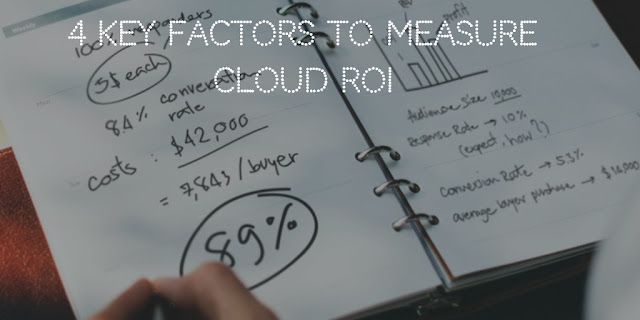4 key factors to measure cloud ROI
Cloud computing is far from a brand-new concept. Internet-based e-mail providers, for example, have been operating in Cloud surroundings for several years. But it is supposedly the next step in the growth of the internet. Increasingly more businesses are exploring the changes that cloud computing brings in.
Switching to the Cloud system may provide SME, startups or even big enterprises a substantial business opportunity to reinvent themselves.
The brief theory behind cloud computing is that resources are exposed as a service as opposed to as a product. Acting as a substitute for conventional systems, it is a web-based provider which hosts data and software. Cloud computing might be divided into 3 parts: Infrastructure-as-a-Service, software-as-a-service, and Platform-as-a-Service. The user can select the number of services to retrieve information that is stored. Clouds environments such as Amazon AWS, Microsoft Azure, and Google GCP are readily available to any user.
An illustration of a simple public cloud is Gmail, that everyone uses in the day in or out. Gmail is part of Google g-suite. G-suite helps users access information and contacts stored inside the Cloud system of Google. Cloud computing has many differences when compared to conventional hosting systems. The key differences could be identified by a couple key characteristics. It functions on a supply and demand system, meaning the consumer can use the more or as little of the provider as needed and will be charged accordingly. It's also considered an elastic service since the user can scale down or up their usage at any moment. That too without expensive upgrades into hardware or software. Another unique characteristic of cloud computing is that all the programs are run on a separate (virtual) machine. Cloud service provider manages the whole infrastructure. So all that user needs is a computer (or client) and internet to access resources in the cloud environment. Among the biggest advantages to this kind of hosting program is the increased flexibility. The billing is set up compared to the way one is charged for water or electricity. With the service Supplier hosting all the information which would normally be saved on to the internal server, more information can be saved because of the huge capacity of the Cloud.
An initiative from The Open Group has developed a set of key considerations for how to derive ROI for cloud computing initiatives from a business perspective. By examining the advantages that cloud computing provides to organizations and enterprises and showing the potential return on investment it can provide from the start, companies might find it easier to gain buy-in for cloud initiatives from the executive team, and also the IT department. Cloud computing has been described as technological change brought about by the convergence of a number of new and existing technologies. What sets the promise of cloud computing apart is the rate of change, the magnitude of cost reduction and specific technical performance impact. This change by cloud computing isn't simply incremental, but it can give from five to 10 times the order of magnitude of improvement.
The famous graphic utilized by Amazon Web Services aka AWS illustrating the capacity versus use curve. It became a standard of measurement in the cloud computing. This model is significant to businesses because one of the main precepts of cloud computing is to avoid the cost impact of over-provisioning and under provisioning of computing resources. This benefit is in addition to the opportunity for cost, revenue, and margin benefits of business services enabled by rapid deployment of cloud services with a low entry cost, and also the potential to enter and exploit new markets.
If cloud computing is defined in historical context then capacity versus utilization curve would be analogous to Moore's Law which is often referred to CPU speed in computing or IT industry.
The problem with using the view of capacity and utilization alone is that it is a technology provider\seller viewpoint essentially based on key performance indicators rather than business benefit metrics. What's needed instead is a set of business metrics that build on the cloud computing model and examining the benefits of technological investments delivered through business lenses.
Cost reduction:
It is easy to reduce the cost of adoption and de-adoption in the cloud due to its service and on-demand nature. Cloud makes it easy to adopt new business models at fraction of cost of traditional model where initial investment is huge, less CapEx. This creates additional cost transformation benefits which are a goal of business improvement programs. The total cost benefits availed by cloud computing environment enables businesses to invest and pursue new market opportunities and build better capability portfolio.Faster delivery and improvised time to market:
This is the way to measure business benefit where faster provisioning, pre-built services, and components can be used and stitched together to bring more customer value out of existing or by building new capabilities.Brand benefits:
Cloud computing makes it possible to build more brand equity for businesses.Reduced risks and the high degree of regulatory compliance:
Cloud mitigates business impacts due to its inherent capabilities such as high availability and ability to stand against disaster. Most of other cloud service providers have their environments certified to different compliance and regulations. It is huge investment savings for healthcare and other critical business segments.While cloud computing is not a free lunch, we can clearly see why businesses are moving to cloud. The rate at which new business models are using cloud environment as the key enabler is outstanding.
Never miss an update. Subscribe and follow to stay informed. Delivered Every Tuesday.
We hate spam too, we will never share your details.

Mandar Pise
Opinions expressed by techsutram contributors are their own. More details
Mandar is a seasoned software professional for more than a decade. He is Cloud, AI, IoT, Blockchain and Fintech enthusiast. He writes to benefit others from his experiences. His overall goal is to help people learn about the Cloud, AI, IoT, Blockchain and Fintech and the effects they will have economically and socially in the future.
Weekly Newsletter
Never miss an update. Subscribe and follow to stay informed.
Delivered Every Tuesday.
Delivered Every Tuesday.
Thank you! You have successfully subscribed to our newsletter.
We hate spam too, we will never share your details.





.jpg)

No comments:
Post a Comment
Your valuable comments are welcome. (Moderated)